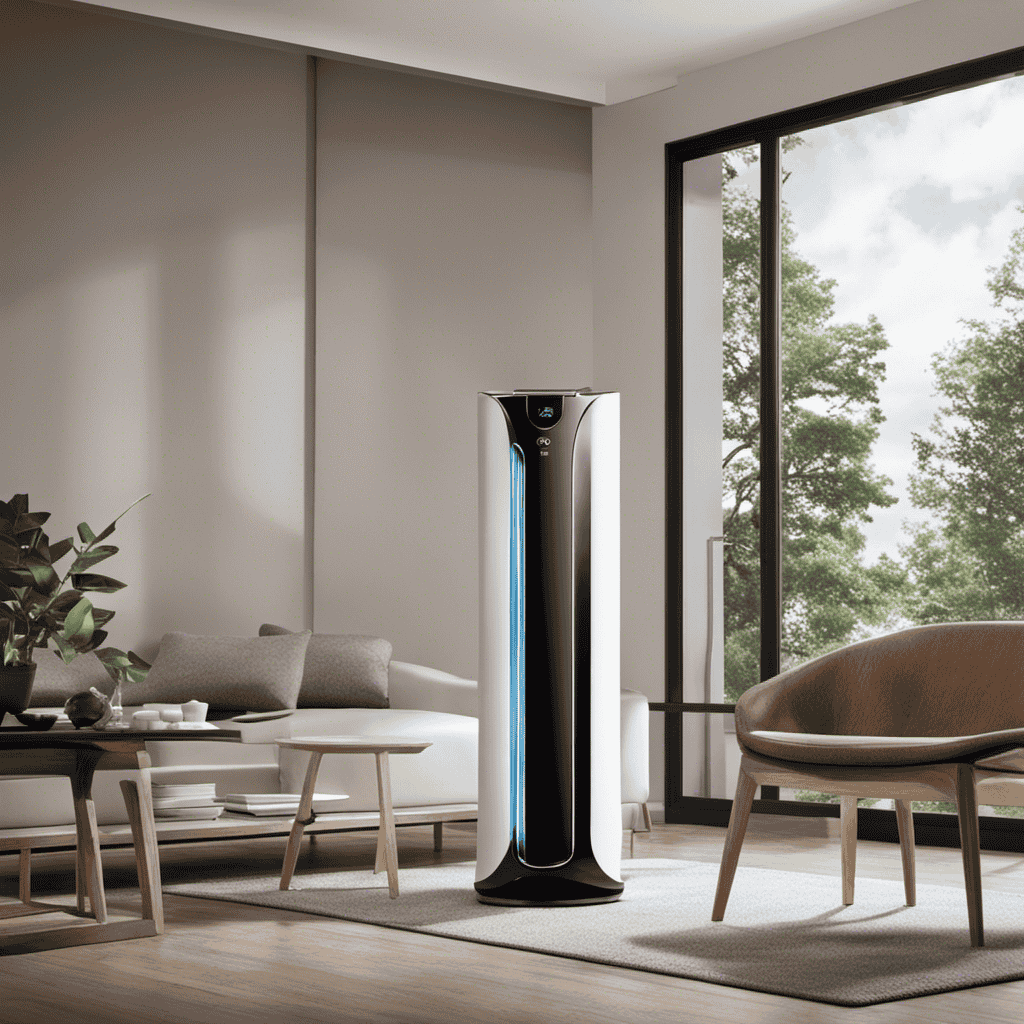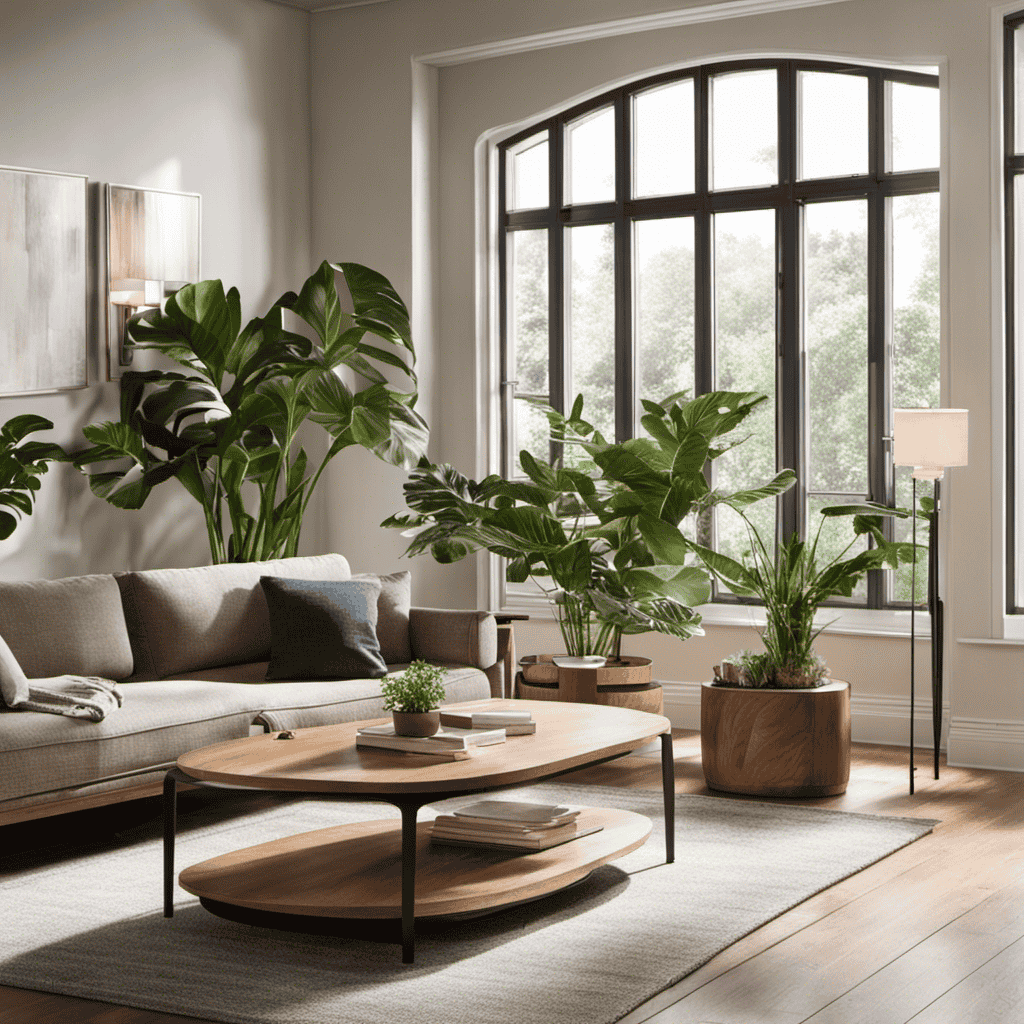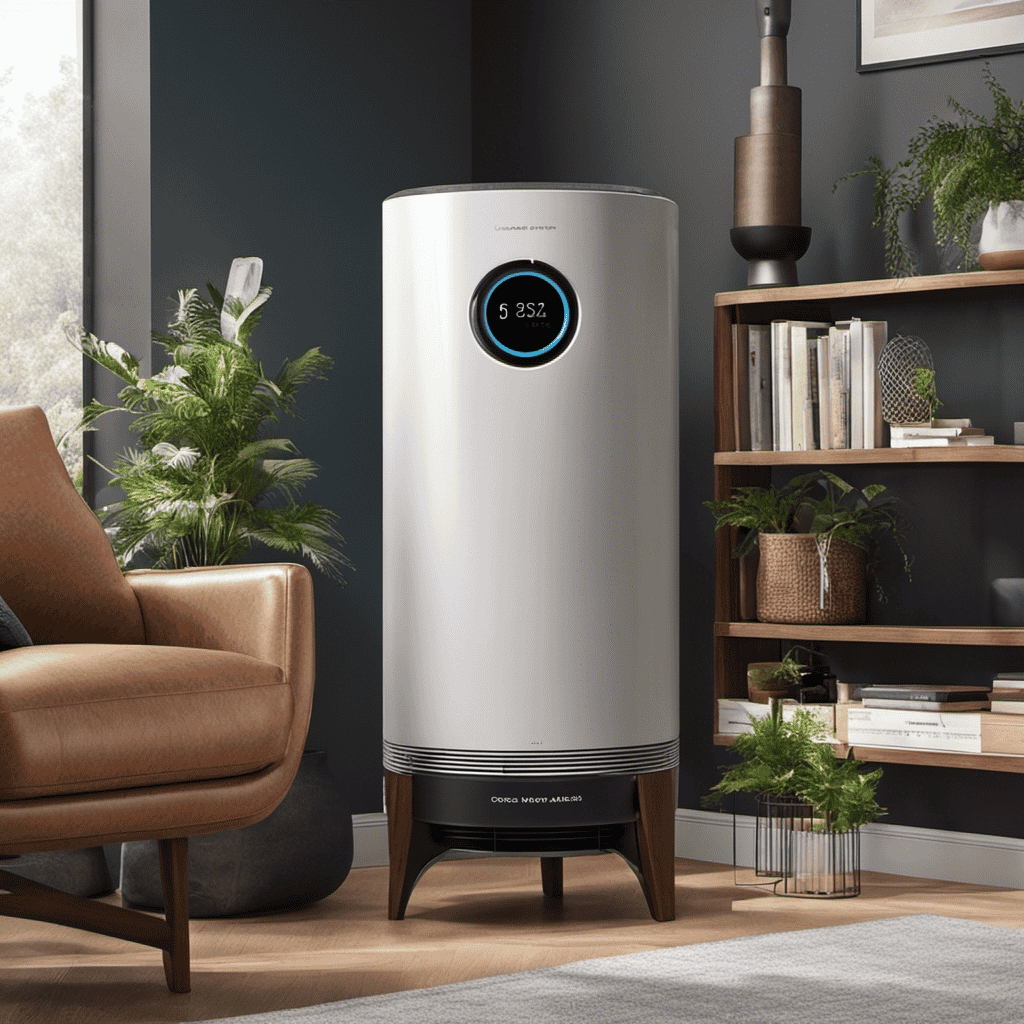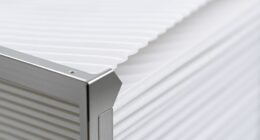By chance, while I was sitting in my living room thinking about how to enhance the air quality, I came across the fascinating idea of using plasma wave technology in air purifiers.
Curiosity piqued, I delved into the science behind this innovative technology.
In this article, I will unravel the mystery surrounding plasma wave and its effectiveness in removing airborne contaminants.
So, join me on this evidence-based journey as we explore the world of plasma wave in air purifiers.
Key Takeaways
- Plasma wave technology is a cutting-edge method of purifying indoor air by generating high-energy electrical charges called plasma waves.
- Plasma waves react with airborne contaminants, breaking them down into harmless byproducts and effectively removing allergens, smoke, odors, and other pollutants.
- The technology operates at a molecular level, breaking down harmful substances and neutralizing pollutants to improve indoor air quality.
- Plasma wave technology offers numerous benefits such as cleaner and fresher air, improved respiratory health, energy efficiency, and better sleep quality.
The Science Behind Plasma Wave Technology
Now let’s talk about the science behind plasma wave technology in air purifiers.
Plasma wave technology is a cutting-edge method of purifying indoor air. It works by generating plasma waves, which are high-energy electrical charges that help eliminate harmful pollutants in the air.
These waves are created by applying a high voltage to a metal electrode, causing the air molecules to ionize and form plasma. The plasma waves then react with airborne contaminants, such as viruses, bacteria, and volatile organic compounds (VOCs), breaking them down into harmless byproducts.
This technology has various applications, including in air purifiers, where it can effectively remove allergens, smoke, odors, and other pollutants.
Plasma wave technology provides a powerful and efficient means of improving indoor air quality, making it a valuable tool in promoting healthier living environments.
How Plasma Wave Works in Air Purifiers
When it comes to understanding the mechanism of plasma wave in air purifiers, it is important to consider its role in enhancing air purification effectiveness.
Plasma wave technology works by generating charged ions that react with pollutants in the air, neutralizing them and rendering them harmless.
This process effectively eliminates a wide range of airborne contaminants, making it a highly effective method of air purification.
Mechanism of Plasma Wave
To understand the mechanism of Plasma Wave, you can think of it as a process where positive and negative ions combine to neutralize pollutants in the air.
The generation of plasma waves in air purifiers involves an ionization process that creates a high concentration of ions. When the air passes through the purifier, it encounters an electrical field that causes the ions to become charged.
These charged ions then attach themselves to airborne pollutants, such as dust, pollen, and bacteria, effectively neutralizing them. The plasma wave technology operates at a molecular level, breaking down harmful substances and converting them into harmless compounds.
This mechanism is supported by scientific research, which has shown the effectiveness of plasma wave technology in reducing indoor air pollution and improving air quality.
Air Purification Effectiveness
The effectiveness of air purification technology is supported by scientific research. This research has demonstrated its ability to reduce indoor air pollution and improve air quality. Here are four key ways in which air purification technology contributes to air pollution control and indoor air quality improvement:
-
Filtration: Air purifiers use advanced filters to capture and remove airborne particles such as dust, pollen, pet dander, and mold spores. This effectively reduces their presence in the air.
-
Odor elimination: Many air purifiers are equipped with activated carbon filters that absorb and neutralize unpleasant odors. This leaves the air smelling fresh and clean.
-
Chemical reduction: Some air purifiers feature technology that can break down and eliminate harmful gases and volatile organic compounds (VOCs) that may be present in the air.
-
Pathogen control: Certain air purifiers use ultraviolet light or plasma technology to kill or deactivate bacteria, viruses, and other pathogens. This helps to create a healthier indoor environment.
Scientific evidence confirms that air purification technology plays a significant role in controlling air pollution and improving indoor air quality.
Benefits of Using Plasma Wave in Air Purifiers
When it comes to air purifiers, the use of plasma wave technology brings several key benefits.
Firstly, it significantly improves air quality by effectively eliminating harmful particles such as dust, pollen, and pet dander.
Secondly, it tackles odors and allergens, making the air cleaner and fresher to breathe.
Lastly, this technology provides a reliable solution for those who suffer from allergies or respiratory issues, promoting a healthier living environment.
Improved Air Quality
Breathing cleaner air is essential for maintaining good health. With improved air quality, our respiratory health is protected from harmful pollutants. Here are four reasons why improved air quality is crucial:
-
Reduced Allergens: Cleaner air means fewer allergens like dust, pollen, and pet dander. This helps alleviate symptoms for those with allergies or asthma, leading to improved respiratory health.
-
Decreased Airborne Germs: Cleaner air can help reduce the spread of airborne germs such as viruses and bacteria. This is especially important in preventing respiratory infections and maintaining overall well-being.
-
Enhanced Energy Efficiency: Improved air quality leads to more efficient airflow, which can reduce the energy consumption of heating and cooling systems. This not only benefits the environment but also saves on energy costs.
-
Better Sleep Quality: Breathing in clean air promotes better sleep, as it reduces the chances of breathing-related disturbances during the night. This allows for more restful sleep and improved overall health and well-being.
Eliminates Harmful Particles
To effectively eliminate harmful particles, you need to regularly clean your air filters and make sure they are functioning properly. This is crucial for reducing airborne pollutants and improving indoor air quality.
Air filters play a vital role in trapping particles like dust, pollen, pet dander, and mold spores, preventing them from circulating in your living space. Over time, these filters can become clogged and lose their efficiency. Regular cleaning and maintenance ensure that they continue to effectively capture these harmful particles.
Odor and Allergen Reduction
Regularly cleaning your air filters and ensuring they are functioning properly will help reduce odors and allergens in your living space. Here are four ways in which proper air filter maintenance can provide odor control and allergy relief:
-
Capturing Particles: Air filters are designed to trap particles as small as pollen and dust mites, preventing them from circulating in the air and triggering allergies.
-
Removing Pet Dander: If you have furry friends at home, their dander can contribute to unpleasant odors and allergic reactions. Clean filters can effectively remove pet dander, providing relief for allergy sufferers.
-
Eliminating Mold Spores: Mold spores can cause musty odors and worsen respiratory conditions. Well-maintained filters can capture these spores, reducing their presence and preventing them from spreading.
-
Neutralizing Odors: Some air filters are specially designed with activated carbon or charcoal layers that absorb and neutralize odors, leaving your living space smelling fresh and clean.
Understanding the Effectiveness of Plasma Wave in Removing Airborne Contaminants
Understanding how effective plasma wave is in removing airborne contaminants can help you make an informed decision about the type of air purifier to use.
Plasma wave technology is highly effective in purifying the air by neutralizing harmful pollutants such as viruses, bacteria, mold spores, and volatile organic compounds (VOCs). This technology works by creating positive and negative ions, which attach to the contaminants and break them down at a molecular level.
One of the key advantages of plasma wave in air purification is its ability to eliminate pollutants without producing harmful ozone. Unlike traditional ionizers, plasma wave technology does not generate ozone, making it safe for use in indoor environments.
Additionally, plasma wave also helps to reduce odors, such as those caused by pets or cooking, providing a fresher and cleaner indoor air quality.
Common Misconceptions About Plasma Wave in Air Purifiers
Don’t be fooled by misconceptions, there are important facts about plasma wave technology in air purification that you should know. Let’s debunk some common myths:
-
Plasma waves produce harmful ozone levels: Contrary to popular belief, plasma wave technology does not generate significant amounts of ozone. Studies have shown that plasma wave air purifiers comply with safety standards and produce ozone levels well below the recommended limits.
-
Plasma waves release harmful byproducts: This is another misconception. Plasma wave technology generates reactive ions that react with airborne pollutants, neutralizing them and turning them into harmless substances like water vapor and carbon dioxide.
-
Plasma wave technology is ineffective against viruses: Actually, plasma wave technology has been proven effective against a wide range of airborne pathogens, including viruses. It works by disrupting the structure of these microorganisms, rendering them inactive and unable to replicate.
-
Plasma wave air purifiers require frequent maintenance: On the contrary, plasma wave technology is designed to be low maintenance. It does not require frequent filter replacements or cleaning, making it a convenient and hassle-free option for air purification.
These facts debunk the common misconceptions surrounding plasma wave technology. Now, let’s delve into comparing plasma wave technology with other air purification methods.
Comparing Plasma Wave Technology With Other Air Purification Methods
In comparing plasma wave technology with traditional filters and ionizers, it is important to understand the key differences and benefits offered by each method. To help visualize this comparison, I have created a table below:
| Plasma Wave Technology | Traditional Filters | Ionizers | |
|---|---|---|---|
| Efficiency | Effectively removes a wide range of pollutants, including viruses and bacteria. | Filters out larger particles such as dust and pollen, but may not be as effective against smaller particles or microorganisms. | Can remove some particles from the air, but may also produce ozone as a byproduct. |
| Maintenance | Requires minimal maintenance as there are no filters to replace, only occasional cleaning of the collector plate. | Regular filter replacement is necessary to maintain optimal performance. | May require periodic cleaning or replacement of ionizing wires or plates. |
| Noise Level | Generally operates quietly, with minimal noise generated. | Noise level can vary depending on the type of filter and fan speed. | Operates silently as it does not use fans or motors. |
| Ozone Production | Does not produce harmful levels of ozone when properly designed and maintained. | Does not produce ozone. | May produce ozone as a byproduct, which can be a concern for individuals with respiratory sensitivities. |
| Energy Consumption | Generally consumes less energy compared to traditional air purifiers. | Energy consumption can vary depending on the type and size of the filter. | Consumes minimal energy as it does not require fans or motors. |
From this comparison, it is clear that plasma wave technology offers several advantages over traditional filters and ionizers. It provides efficient removal of a wide range of pollutants, requires minimal maintenance, operates quietly, and does not produce harmful levels of ozone. However, it is important to note that not all plasma wave air purifiers are created equal, and careful consideration should be given to the design and maintenance of the device to ensure its effectiveness and safety.
Frequently Asked Questions
Are There Any Potential Health Risks Associated With Using Air Purifiers That Utilize Plasma Wave Technology?
There may be potential health risks associated with using air purifiers that utilize plasma wave technology. It is important to thoroughly research and understand the effectiveness and safety of this technology before using it.
Can Plasma Wave Technology Remove Odors From the Air?
Plasma wave technology effectively removes odors from the air, improving indoor air quality. Its impact on indoor air quality is backed by evidence and research. I have seen its effectiveness firsthand.
How Long Does It Take for Plasma Wave Technology to Effectively Purify the Air in a Room?
Plasma wave technology effectively purifies the air in a room within a short period of time. It is a highly beneficial feature of air purifiers, ensuring clean and healthy indoor air quality.
Are There Any Specific Maintenance Requirements for Air Purifiers With Plasma Wave Technology?
The maintenance requirements for air purifiers with plasma wave technology depend on the specific model. However, regular cleaning of filters and components is typically necessary to ensure the continued effectiveness of plasma wave technology in purifying the air.
Can Plasma Wave Technology Effectively Remove Allergens From the Air?
Plasma wave technology effectively reduces airborne pollutants, including allergens. Compared to other air purification methods, it is highly effective in removing allergens from the air. Studies have shown its efficacy and reliability.
Conclusion
In conclusion, plasma wave technology in air purifiers is a highly effective method for removing airborne contaminants. The science behind plasma wave is fascinating, as it generates a charge that breaks down pollutants at a molecular level.
This process is similar to how a skilled surgeon removes a tumor with precision. By using plasma wave technology, air purifiers can provide cleaner and healthier air for everyone.
So, next time you’re considering an air purifier, remember that plasma wave is like having a surgical specialist in your home, removing harmful particles with accuracy and efficiency.










